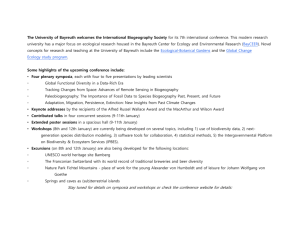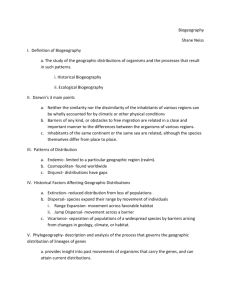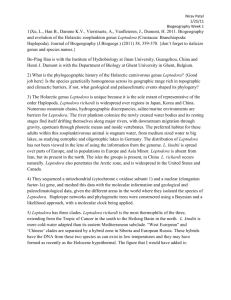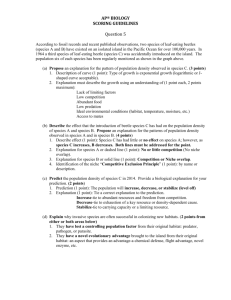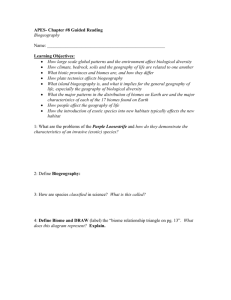Table S1. Classification of niche breadth measures into habitat, diet
advertisement
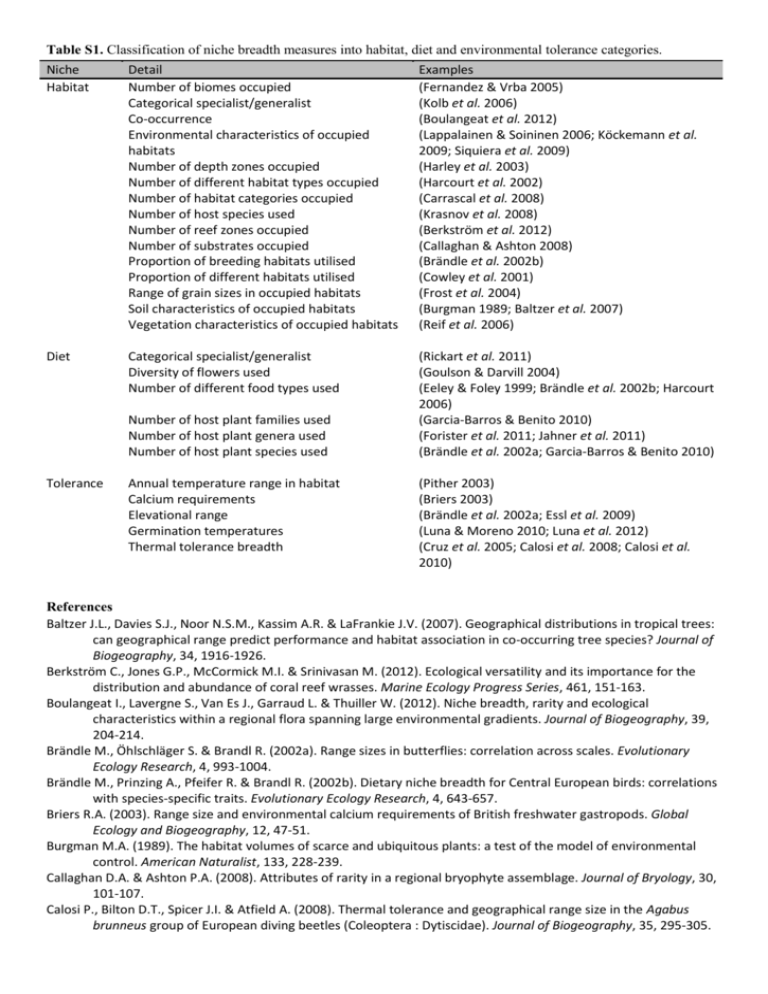
Table S1. Classification of niche breadth measures into habitat, diet and environmental tolerance categories. Niche Detail Examples Habitat Number of biomes occupied (Fernandez & Vrba 2005) Categorical specialist/generalist (Kolb et al. 2006) Co-occurrence (Boulangeat et al. 2012) Environmental characteristics of occupied (Lappalainen & Soininen 2006; Köckemann et al. habitats 2009; Siquiera et al. 2009) Number of depth zones occupied (Harley et al. 2003) Number of different habitat types occupied (Harcourt et al. 2002) Number of habitat categories occupied (Carrascal et al. 2008) Number of host species used (Krasnov et al. 2008) Number of reef zones occupied (Berkström et al. 2012) Number of substrates occupied (Callaghan & Ashton 2008) Proportion of breeding habitats utilised (Brändle et al. 2002b) Proportion of different habitats utilised (Cowley et al. 2001) Range of grain sizes in occupied habitats (Frost et al. 2004) Soil characteristics of occupied habitats (Burgman 1989; Baltzer et al. 2007) Vegetation characteristics of occupied habitats (Reif et al. 2006) Diet Categorical specialist/generalist Diversity of flowers used Number of different food types used Number of host plant families used Number of host plant genera used Number of host plant species used Tolerance Annual temperature range in habitat Calcium requirements Elevational range Germination temperatures Thermal tolerance breadth (Rickart et al. 2011) (Goulson & Darvill 2004) (Eeley & Foley 1999; Brändle et al. 2002b; Harcourt 2006) (Garcia-Barros & Benito 2010) (Forister et al. 2011; Jahner et al. 2011) (Brändle et al. 2002a; Garcia-Barros & Benito 2010) (Pither 2003) (Briers 2003) (Brändle et al. 2002a; Essl et al. 2009) (Luna & Moreno 2010; Luna et al. 2012) (Cruz et al. 2005; Calosi et al. 2008; Calosi et al. 2010) References Baltzer J.L., Davies S.J., Noor N.S.M., Kassim A.R. & LaFrankie J.V. (2007). Geographical distributions in tropical trees: can geographical range predict performance and habitat association in co-occurring tree species? Journal of Biogeography, 34, 1916-1926. Berkström C., Jones G.P., McCormick M.I. & Srinivasan M. (2012). Ecological versatility and its importance for the distribution and abundance of coral reef wrasses. Marine Ecology Progress Series, 461, 151-163. Boulangeat I., Lavergne S., Van Es J., Garraud L. & Thuiller W. (2012). Niche breadth, rarity and ecological characteristics within a regional flora spanning large environmental gradients. Journal of Biogeography, 39, 204-214. Brändle M., Öhlschläger S. & Brandl R. (2002a). Range sizes in butterflies: correlation across scales. Evolutionary Ecology Research, 4, 993-1004. Brändle M., Prinzing A., Pfeifer R. & Brandl R. (2002b). Dietary niche breadth for Central European birds: correlations with species-specific traits. Evolutionary Ecology Research, 4, 643-657. Briers R.A. (2003). Range size and environmental calcium requirements of British freshwater gastropods. Global Ecology and Biogeography, 12, 47-51. Burgman M.A. (1989). The habitat volumes of scarce and ubiquitous plants: a test of the model of environmental control. American Naturalist, 133, 228-239. Callaghan D.A. & Ashton P.A. (2008). Attributes of rarity in a regional bryophyte assemblage. Journal of Bryology, 30, 101-107. Calosi P., Bilton D.T., Spicer J.I. & Atfield A. (2008). Thermal tolerance and geographical range size in the Agabus brunneus group of European diving beetles (Coleoptera : Dytiscidae). Journal of Biogeography, 35, 295-305. Calosi P., Bilton D.T., Spicer J.I., Votier S.C. & Atfield A. (2010). What determines a species' geographical range? Thermal biology and latitudinal range size relationships in European diving beetles (Coleoptera: Dytiscidae). Journal of Animal Ecology, 79, 194-204. Carrascal L.M., Seoane J., Palomino D. & Polo V. (2008). Explanations for bird species range size: ecological correlates and phylogenetic effects in the Canary Islands. Journal of Biogeography, 35, 2061-2073. Cowley M.J.R., Thomas C.D., Wilson R.J., Leon-Cortes J.L., Gutierrez D. & Bulman C.R. (2001). Density-distribution relationships in British butterflies. II. An assessment of mechanisms. Journal of Animal Ecology, 70, 426-441. Cruz F.B., Fitzgerald L.A., Espinoza R.E. & Schulte J.A. (2005). The importance of phylogenetic scale in tests of Bergmann's and Rapoport's rules: lessons from a clade of South American lizards. Journal of Evolutionary Biology, 18, 1559-1574. Eeley H.A.C. & Foley R.A. (1999). Species richness, species range size and ecological specialisation among African primates: geographical patterns and conservation implications. Biodiversity and Conservation, 8, 1033-1056. Essl F., Staudinger M., Stöhr O., Schratt-Ehrendorfer L., Rabitsch W. & Niklfeld H. (2009). Distribution patterns, range size and niche breadth of Austrian endemic plants. Biological Conservation, 142, 2547-2558. Fernandez M.H. & Vrba E.S. (2005). Macroevolutionary processes and biomic specialization: testing the resource-use hypothesis. Evolutionary Ecology, 19, 199-219. Forister M.L., Jahner J.P., Casner K.L., Wilson J.S. & Shapiro A.M. (2011). The race is not to the swift: Long-term data reveal pervasive declines in California's low-elevation butterfly fauna. Ecology, 92, 2222-2235. Frost M.T., Attrill M.J., Rowden A.A. & Foggo A. (2004). Abundance-occupancy relationships in macrofauna on exposed sandy beaches: patterns and mechanisms. Ecography, 27, 643-649. Garcia-Barros E. & Benito H.R. (2010). The relationship between geographic range size and life history traits: is biogeographic history uncovered? A test using the Iberian butterflies. Ecography, 33, 392-401. Goulson D. & Darvill B. (2004). Niche overlap and diet breadth in bumblebees: are rare species more specialized in their choice of flowers? Apidologie, 35, 55-63. Harcourt A.H. (2006). Rarity in the tropics: biogeography and macroecology of the primates. Journal of Biogeography, 33, 2077-2087. Harcourt A.H., Coppeto S.A. & Parks S.A. (2002). Rarity, specialization and extinction in primates. Journal of Biogeography, 29, 445-456. Harley C.D.G., Smith K.F. & Moore V.L. (2003). Environmental variability and biogeography: the relationship between bathymetric distribution and geographical range size in marine algae and gastropods. Global Ecology and Biogeography, 12, 499-506. Jahner J.P., Bonilla M.M., Badik K.J., Shapiro A.M. & Forister M.L. (2011). Use of exotic hosts by lepidoptera: widespread species colonize more novel hosts. Evolution, 65, 2719-2724. Köckemann B., Buschmann H. & Leuschner C. (2009). The relationships between abundance, range size and niche breadth in Central European tree species. Journal of Biogeography, 36, 854-864. Kolb A., Barsch F. & Diekmann M. (2006). Determinants of local abundance and range size in forest vascular plants. Global Ecology and Biogeography, 15, 237-247. Krasnov B.R., Mouillot D., Khokhlova I.S., Shenbrot G.I. & Poulin R. (2008). Scale-invariance of niche breadth in fleas parasitic on small mammals. Ecography, 31, 630-635. Lappalainen J. & Soininen J. (2006). Latitudinal gradients in niche breadth and position - regional patterns in freshwater fish. Naturwissenschaften, 93, 246-250. Luna B. & Moreno J.M. (2010). Range-size, local abundance and germination niche-breadth in Mediterranean plants of two life-forms. Plant Ecology, 210, 85-95. Luna B., Pérez B., Torres I. & Moreno J.M. (2012). Effects of incubation temperature on seed germination of Mediterranean plants with different geographical distribution ranges. Folia Geobotanica, 47, 17-27. Pither J. (2003). Climate tolerance and interspecific variation in geographic range size. Proceedings of the Royal Society B, 270, 475-481. Reif J., Hořák D., Sedláček O., Riegert J., Pešata M., Hrázský Z., Janeček Š. & Storch D. (2006). Unusual abundancerange size relationship in an Afromontane bird community: the effect of geographical isolation? Journal of Biogeography, 33, 1959-1968. Rickart E.A., Balete D.S., Rowe R.J. & Heaney L.R. (2011). Mammals of the northern Philippines: tolerance for habitat disturbance and resistance to invasive species in an endemic insular fauna. Diversity and Distributions, 17, 530-541. Siquiera T., Bini L.M., Cianciaruso M.V., Roque F.O. & Trivinho-Strixino S. (2009). The role of niche measures in explaining the abundance-distribution relationship in tropical lotic chironomids. Hydrobiologia, 636, 163172.
